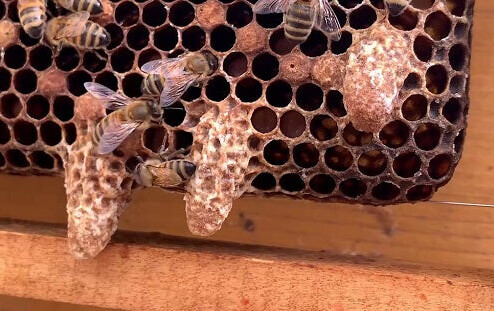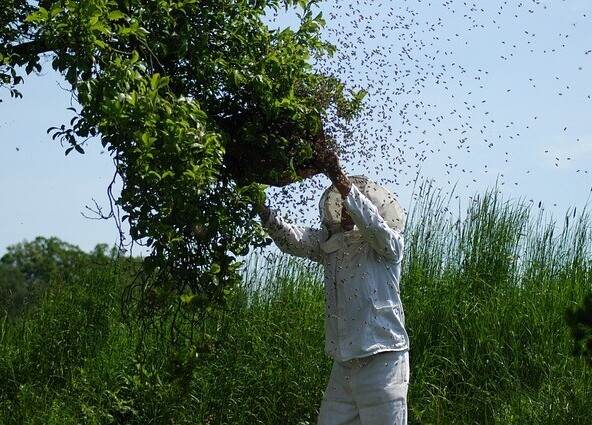Swarming in bee colonies is like nature’s way of bees saying, ‘We need more space!’ It’s a pretty normal behavior that happens when a colony gets too large. Here’s the thing, swarming isn’t just about overcrowding; it’s also a vital part of the bee’s lifecycle. Bees are absolute pros at multiplying and swarming is one way they spread and establish new colonies.
Bee colonies have their social structure down to a science. When the hive gets crowded, worker bees start raising new queens. The old queen and a bunch of workers will then take off to find a new home, leaving the new queen and the rest behind. This behavior makes swarming a fascinating yet challenging part of managing an apiary.
The impact of swarming on your honey production can be a big deal. When bees swarm, they take a significant chunk of your workforce with them. That means fewer bees to collect nectar and make honey. Not only that, but when you’re not proactively managing swarming, a lot of potential honey gets lost in the chaos of colony division.
Knowing why and how swarming happens can actually be super beneficial. It lets you strategize and manage your hives better, ensuring both the health of the bee colony and maximizing your honey yield. It’s the foundation to being proactive rather than reactive in bees’ management.
 Queen cells
Queen cells
Preventative Measures to Minimize Swarming
Regular hive inspection and keeping an eye on your colonies is a top priority. It’s much easier to prevent swarming if you catch early signs like queen cells or overcrowded conditions. Having a consistent inspection routine helps you stay on top of what’s happening inside each hive.
- Space matters. Bees thrive when they’ve got room to grow and work. Adequate space in the hive prevents that overcrowded feel, which is a primary trigger for swarming. Adding extra hive boxes or frames as the colony expands can be a great way to keep that space-problem in check.
- Hive splitting is a smart move when you notice signs of potential swarming or if you know a colony is getting simply too big. By creating a new colony with part of your existing one, you’re relieving pressure and reducing the chances of swarming off. It’s an art to get the timing right for splitting, but it’s one worthwhile learning.
- Feeding and resource management can’t be ignored. Sometimes swarming happens because bees feel they’ve absolutely maxed out current resources. Ensuring they have enough of what they need can prevent them from thinking it’s time to branch out.
Keeping colonies shaded and well-ventilated can also be a highly effective strategy. Overheating can add stress to the hive, pushing them towards swarming. Simple measures like ensuring good airflow and a cool environment can make a huge difference.
 Swarming bees
Swarming bees
Intervention Strategies for Active Swarming
Spotting the signs of swarming sooner rather than later is vital. Key signals include bees clustering at the hive entrance and frequent scout bees flying around. Catching these early can be a game-changer, giving you more options to take action before they swarm en masse.
- When a swarm is imminent, quick action is everything. If you see a swarm in the making, try to gather them by using a swarm-catching kit. This involves gently coaxing or shaking the cluster into a box. It’s quite a skill but one that comes in handy for rehousing.
- Once you’ve got your swarm contained, ensure their new home is ready and inviting. Set up a hive that offers comfort and room for growth to encourage them to settle and keep them from taking off again.
- Managing swarmed colonies is all about ensuring both the old and new groups thrive. Be mindful of their health, gradually building them up again. Check on the queen’s wellbeing and monitor the colony’s activity levels to keep everything running smoothly.
It’s a team effort between you and your bees. Assisting them in resettling encourages stability. This means checking for food stores, ensuring reduced stress, and gradually expanding their space as the colony grows back.
Long-term Apiary Management for Swarm Control
Building a successful apiary involves thinking long-term, especially when it comes to minimizing swarming. Sustainable practices are your best friends here. Regular hive management plans that incorporate seasonal needs of your bees can help keep swarming in check while promoting overall hive health and productivity.
Breeding strategies can be a real game-changer in creating low-swarming bee colonies. Select for traits like calmness, low proliferation, and high productivity when you’re introducing new queens or expanding your apiary. Finding the right bee stock plays a huge role in reducing the likelihood of swarming.
Engage with the local beekeeping community. Sharing insights and challenges with fellow beekeepers leads to better practices all around. It also cultivates a cooperative network where swarms can be reported quickly and efficiently. This communal approach adds another layer of support, especially when swarms happen unexpectedly.
A commitment to ongoing education is vital. Stay updated on new techniques and research. Swarm prevention and intervention tactics evolve, and learning from the latest developments provides current best practices ensuring your bees stay productive and healthy.
Incorporating these strategies means you’ll be well-equipped to manage swarming effectively while enjoying a thriving apiary. It’s about finding what works best for you and your buzzing little ecosystem, focusing on the health and harmony of your hive community.
This post may contain affiliate links.

A very interesting hobby or in your case, a life’s work. This is a very well written article with lots of valuable information, even for someone who has no interest in raising Bees. I found it to be very interesting and informative. You break down the care and nurturing of the colony and explained the swarming process very well. Thank you for this very interesting post.
Hi Walter!
Thank you for your kind comments.
Yes, I hope I can share my experiences and provide some valuable information about beekeeping to inspire people!
Maybe some who are thinking about beekeeping and just don’t know where to start, then maybe my posts can be helpful or they can ask me their questions.
I don’t have an Apiary but am a bee enthusiast. I am very interested in the little buggers and how vital they are to our food chain. One thing I would love to know is. How expensive is it to become a bee farmer equipment-wise? My wife is allergic to them so the knowledge is more for me than practical use but I still would love to know.
Hi Andy!
Thank you for your comments and question!
If you want to start your own apiary you first need a good hive for the bees and tool to inspect and manage the hive. Then you need a bee suit to protect yourself and maybe a smoker. Lastly you need som gears to extract and strain the honey. To start with you can buy used tools from other beekeepers for a low cost and then later step up with newer ones, but a beesuit you should always buy a new one that suits you perfecly and are not worn out.
If you want to start with new gears all together, you should follow my link to Amazon. There you could find new stuff for good prices.
/Mats